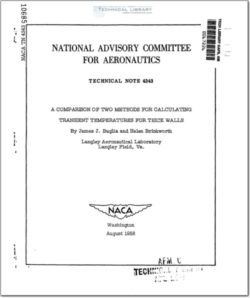NACA-TN-4343

- Version
- 141 Downloads
- 985.54 KB File Size
- 1 File Count
- March 24, 2016 Create Date
- March 24, 2016 Last Updated
A Comparison of Two Methods for Calculating Transient Temperatures for Thick Walls

A comparison is made of two different methods of calculating tran-
sient temperatures for thick walls with arbitrary variation of heat-
transfer coefficient and adiabatic-wall temperature. Although numerical
calculations for special cases for which the exact solutions are avail—
able show that both methods give satisfactory results, Hill‘s method
(NACA Technical Note #105) consistently gives nearly exact results with
considerably less computing time, except for the case in which a tempera-
ture profile through the thick skin is desired. For this case,
Dusinberre's method (Trans. A.S.M.E., vol. 67, no. 8) is much faster,
though less accurate.
No exact analytical method is available for computing the transient
temperature for the general case of thick walls. Various finite-difference
methods have therefore been proposed and used to compute transient wall
temperatures. With the increased importance of high temperature in air—
craft structural design, an evaluation of the merits of representative
methods is warranted.
The existence of several other methods is fully acknowledged and
no comprehensive comparison of all available methods is intended. It
is intended merely to select two representative methods and to compare
their results and computing times. The methods of Hill (ref. 1) and
Dusinberre (ref. 2) have been selected for this purpose. In this paper
only the basic one-dimensional case has been considered. Hand calcula—
tions with a desk computer were made rather than resorting to an elec-
tronic computer, because in many engineering applications fast and direct
answers are required, and in some problems, programing time on a computer
becomes excessive.
The first application of the finite—difference method for determining
thickpwall temperatures is credited to Schmidt (ref. 3). This method
employs a ratio of incremental time to increment of distance into the
wall that is fixed by the material properties of the wall. Dusinberre
has introduced an extension of Schmidt’s method whereby the ratio of
time increment to distance increment can be varied to introduce smaller
time steps if desired. An increase of accuracy relative to Schmidt's
method is thereby possible. Dusinberre's method includes Schmidt's
method and can be reduced to it by the adjustment of a coefficient.
| File | Action |
|---|---|
| naca-tn-4343 A Comparison of Two Methods for Calculating Transient Temperatures for Thick Walls.pdf | Download |

Comment On This Post